As Bob Iger later liked to tell the tale, the idea for buying Pixar came to him while he was watching one of the parades during the opening of Hong Kong Disneyland in September 2005. As he watched, he realized that none of the newer parade characters—that is, characters introduced in the past ten years—were Disney characters. They were all Pixar characters. (I can only conclude that Hong Kong Disneyland did not share my love for Lilo & Stitch.) If Disney was to continue, he thought, the company needed Pixar—and the chief creative genius behind Pixar, John Lasseter.
The problem, of course, was that by 2005, relations between Pixar and Disney had reached a breaking point, with Pixar’s Steve Jobs announcing in early 2004 that he had broken off negotiations with Disney, and would not negotiate with them again until and unless Disney CEO Michael Eisner left the firm. That end, Jobs later confirmed, would come after the release of the 2005 (later 2006) Cars—the final film needed to fulfill the Disney contract. Pixar would lose rights to release sequels of Toy Story, The Incredibles, Monsters Inc. and Cars. Pixar’s John Lasseter felt nearly ill at the thought.
But on the other hand, Pixar could finally create films without needing the approval of the Mouse—and thus, could finally go ahead with a film that gave Disney several marketing qualms: one focused on a rat.
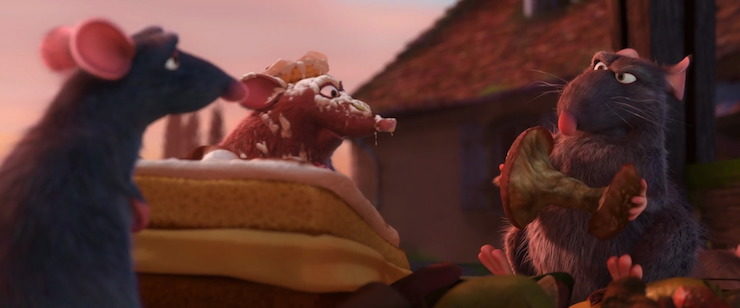
(Rumors that Steve Jobs specifically pushed for the rat film instead of the other possibility, a robot film, purely to counter-symbol Disney’s famous Mouse, have not been confirmed.)
But as Pixar moved forward with the rat film, Michael Eisner found himself in increased trouble at Disney—partly thanks to his feud with Steve Jobs. In March 2005, Eisner left the film, appointing Bob Iger as his successor. With Eisner gone, the chief obstacle between a Disney/Pixar relationship also seemed gone—thus allowing Disney to release the rat film. Possibly. Disney approved moving the release date of Cars from November 2005 to June 2006. Iger headed to Hong Kong Disneyland, and wondered if just maybe—perhaps—maybe—Jobs might agree to a Pixar buyout.
As negotiations for this proceeded, Disney and Pixar set up a separate, just in case everything fell apart, backup distribution deal for Ratatouille—ensuring that the film would be released by Disney and on time even if Disney and Pixar tempers flared up again. That backup plan turned out to be unnecessary: in early 2006, Disney offered $7.4 billion for Pixar, an offer that Steve Jobs, who still owned 50.1% of Pixar, accepted.
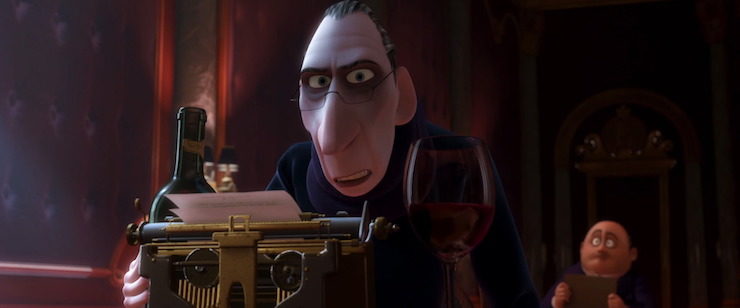
The resulting deal left other Pixar shareholders holding Disney stock, Jobs a permanent seat on the Disney board as Disney’s largest shareholder, and Disney in firm control of Pixar, with John Lasseter gaining a new job at Disney as Chief Creative Officer, supervising both Pixar and the Disney Animation Studios—though Lasseter and other executives stressed that the two animation studios would remain separate.
(This remains mostly true, though Lasseter’s distinctive touch can be seen in all of the subsequent Disney and Pixar films. And in a perhaps not surprising in retrospect development, some of the later Disney films—for instance, Wreck-It Ralph—would end up feeling like “Pixar” films, while as we’ll see, Pixar, in turn, moved on to create the ultimate Disney product: a Disney princess film.)
This was the chaotic background behind the development and production of Ratatouille, finally released in 2007—after all of the negotiations were done. That background perhaps explains why one of the film’s subplots focuses on the eventual ownership of a restaurant famed for its innovation and quality, and another subplot discusses the commercialization of that restaurant’s qualities, with images of its founder slapped on multiple, lesser properties. The ending is bittersweet: for reasons largely beyond the control of the brilliant creatives in its kitchen, the restaurant needs to close, and three of those creatives end up needing to turn to a former rival for financial help.
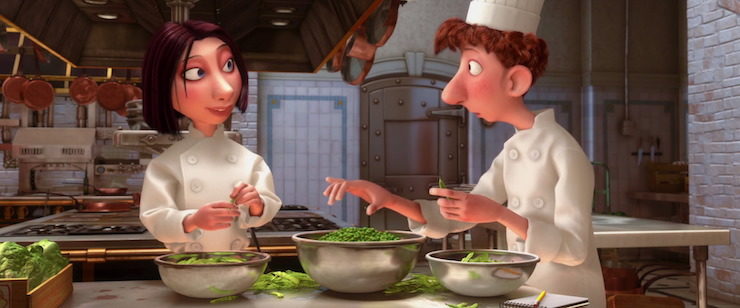
But it would be a mistake to read Ratatouille solely as a metaphor for the strained Pixar/Disney relationship. It is also very much the story of artistry, food, and yes, a rat.
Director Jan Pinkava had been standing in his kitchen when he originally thought of the idea of a rat with dreams of becoming a chef, which leads me to ask all kinds of questions about his kitchen, but let us move on. It took him another three years to write the script and to convince Pixar that small kids would be willing to watch a film about a rat, but by 2003, Pixar had approved his concept, agreeing that it would be their eighth movie.
Just two years later, Pinkava realized that he would not be able to direct the film without assistance, and asked for help—a request that led to Ratatouille getting taken away from him and given first to Bob Peterson, and then to Brad Bird, who had finally wrapped up work on The Incredibles. An upset Jan Pinkava left Pixar, while Brad Bird faced a new technical challenge: trying to get Ratatouille out by a release date of summer 2007—that, although pushed back from its initial planned release date in 2006, still left animators with only 18 months to finish the film. With a script that Brad Bird felt needed a complete overhaul.
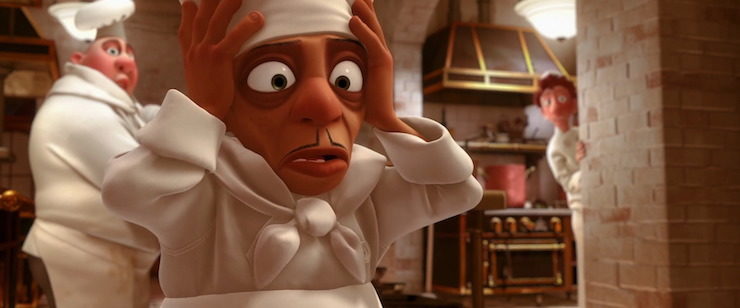
And a need to produce a separate trailer—containing scenes not from the actual film—to be released with Cars in May 2006.
By this time, Pixar animators were almost accustomed to working well behind schedule. Thus, despite the deadline, Pixar animators and designers took several field trips to Paris for inspiration, where they dined at fabulously expensive restaurants, and also contemplated what it might be like to have a chase scene on the Seine River with a rat. (One of the film’s best set pieces, as it turned out.) They also, presumably a bit less pleasantly, took a brief trek into the Paris sewers, which featured in another of the film’s major set pieces.
Back in California, the animators visited culinary schools and chatted with various chefs. Producer Brad Lewis, getting fully into the spirit of things, even tried out a (brief) internship under celebrity chef Thomas Keller, who, if Wikipedia is to believed, has earned seven of the Michelin stars that inspired the star ratings for Ratatouille’s star restaurant, Gusteau. Keller also designed the ratatouille dish, “confit byaldi” for the climax of the film, an elaborate array of fanned-out vegetables that reminds a legendary food critic of the comforts of home. In the film, it rather leaves the impression that surely a skilled rat could find an easier, less elaborate way of preparing vegetables. Though that probably wouldn’t have impressed the critic.
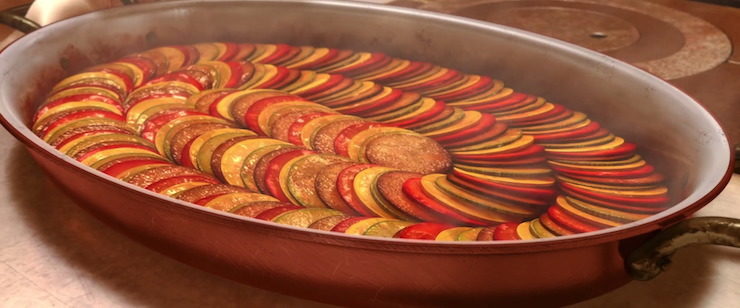
And in a now typical move for animators, who had previously (in Disney days) brought in zoo and circus animals to study, and later (in Pixar days) tropical fish, Pixar brought in several pet rats for animators to watch and draw. They also sent the art department out to take pictures of rotting food, to make sure the piles of rotting food eagerly searched by the rats would look realistic, a touch presumably not approved by all viewers.
For once, computer processing and rendering proved to be lesser issues. As Intel later bragged, Pixar’s rendering software now worked 30% faster. And Pixar animators had learned a significant amount from previous films, making it easier to render fur (Monsters, Inc.), human skin (The Incredibles), water (Finding Nemo) and artificial and natural lights (Cars). The resulting knowledge allowed Pixar to create multiple action packed scenes—and have a moment with a character dripping with water from the Seine. For additional inspiration, animators jumped into a pool wearing chef’s uniforms, to get a full sense of the look.

For the most part, Pixar cast voice actors who could either mimic French accents or were named John Ratzenberger, by now a Pixar staple. (Ratzenberger later confessed that he kept slipping into an Italian accent, requiring his lines to be re-recorded multiple times until the line sounded more French.) The two exceptions: comedian Patton Oswalt, at the time primarily known for his work on The King of Queens, hired for the role after Brad Bird heard Oswalt joke about food, and Lou Romano, at the time primarily known as a storyboard artist and production designer, who had previously worked with Brad Bird on Iron Giant and The Incredibles. Producer Brad Lewis also popped in to do a few additional voices.
In a studio first, two of those “voice actors who could mimic French accents” turned out to be major Shakespeare thespians Sir Ian Holm and Peter O’Toole—the latter almost managing to vanish into his role as a food critic until his final speech about criticism and art, at which point the character disappears and Peter O’Toole emerges. Criticism and art (and many other things) was the sort of thing that Peter O’Toole could and did comment on, at length, even when not in front of a camera or near any recording equipment, so it works in any case, and age did not end his sonorous tones. It was to be one of his last roles.
Most of the film, however, is less about the food critic, and more about the rats. Specifically, one rat, Remy, a rat with a very large family, who has grown up watching and obsessing over cooking shows, especially shows featuring Auguste Gusteau. (The underlying moral lesson here seems to be that if you don’t want rats in your kitchen, don’t turn on cooking shows. Watch cartoons instead. I’m not saying that Pixar and Disney had an ulterior motive here, mind you; I’m just reporting what’s on screen.) This obsession leads him to try cooking on top of the roof and nearly getting fried with lightning, as well as several forbidden trips to a human kitchen. In one of these trips, he ends up caught—and forced, with the other rats, from his home as an elderly woman fires a shotgun at all of them. Remy is soon separated from the rest of the rats, finding himself alone and wet and miserable. In Paris.

Since he’s in Paris, naturally he does the main thing everyone wants to do in Paris—go to a fine restaurant—the one founded by his hero, Gusteau. His motives for choosing the restaurant over, say, the educational possibilities of the Louvre are perhaps slightly influenced by his hunger and his cooking obsession, but still, I can hardly blame him for heading in that direction. I can perhaps blame him for deciding to cook some soup in the restaurant’s kitchen instead of—just a suggestion—taking some food away to nibble on later, but the soup ends up being truly magnificent, so I suppose this was, in the end, a good thing.
His presence in the kitchen does not exactly go unnoticed. New hire Alfredo Linguini, not quite as Italian as he might sound, notices Remy, and after a brief moment of horror, realizes how bright the rat is, and decides to pair up with him. After considerable trial and effort, they realize that if Remy pulls on Linguini’s hair, kinda like a puppet, it will be painful—but it will also let the rat guide Linguini’s cooking, turning the kid into a chef.
And that’s mostly it. Sure, Ratatouille has some subplots here and there—the previously mentioned “who really owns this restaurant”; a long standing feud with a restaurant critic; a small but sweet romance between Linguini and one of the other cooks, Colette; and various high speed chase scenes, including a wild moment over the Seine River which—gulp—almost leads to Remy’s death, gulp gulp. An equally impressive moment happens earlier in the film, as Remy wanders through the roofs and attics of Paris homes, catching glimpses of life below. (Pay very close attention, and you just might see a character from a film then just entering development—Up.) Ratatouille also has an until-then unheard of for Pixar (or Disney) plot involving an out-of-wedlock child who has grown up not knowing his father (and, it turns out, not inheriting the guy’s gift for cooking), and a plot involving a colony of rats who really just want something to eat.
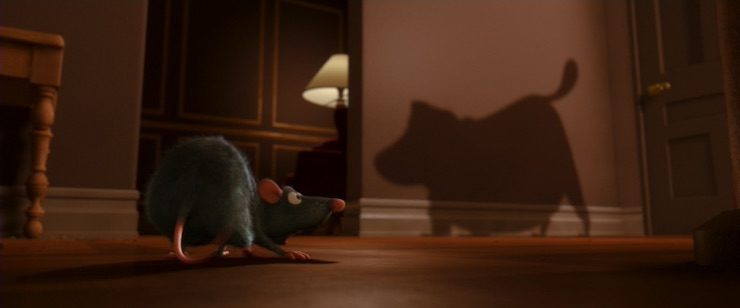
But all of this, along with the Disney/Pixar analogies, is just surface stuff. At its heart, Ratatouille is about pursuing your dreams, about art, and about what you might sacrifice for your art—or, in the case of Skinner, your hopes for big piles of cash. It’s not just Remy, either: a sideplot about Colette Tatou, for instance. shows how hard she’s worked to obtain a position supervising meat preparation at Gusteau. And astonishingly enough, for all its fantasy and insistence that yes, yes, you can achieve your dreams if you pursue them, Ratatouille is surprisingly realistic.
No one in this film achieves their dreams without hard luck and multiple setbacks. Even though they eventually help out, Remy’s family is not initially supportive of his dream. Quite the contrary: they put him to work sniffing out food for poison—useful, but hardly intellectually stimulating. It’s no wonder that Remy ends up sneaking off to the kitchen to watch cooking shows, or that, once separated from his family, he does not exactly try all that hard to look for them—choosing to settle in with a restaurant instead. The other cooks (understandably) refuse to cook with a rat in the kitchen, and Remy’s genuine success turns into a complete failure when the restaurant is closed down for health concerns, forcing him to try again.
In other words, the film suggests that yes, you can succeed—if you are willing to try a second time, and a third time, and maybe even more times than that—something that echoes Brad Bird’s own life and Hollywood career, a series of ups and downs.
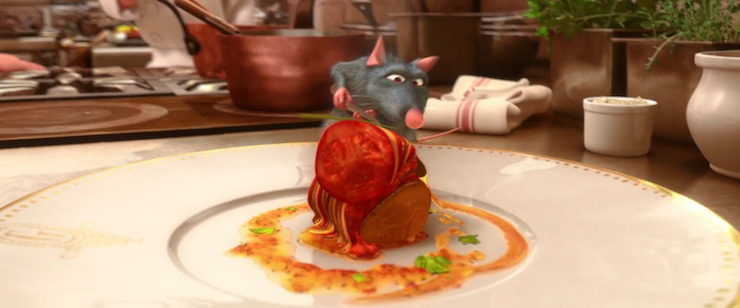
I do have one quibble—even by Disney and Pixar standards, Ratatouille is an incredibly male dominated film, with only a few women: the elderly woman at the beginning of the film who chases the rats out of her home and tries to kill them, a random street woman with a single line, a woman who shoots her boyfriend in a blink and you’ll miss it moment, and rotisseur chef Colette. Linguini’s now-dead mother, never appearing in the film, writes a letter that eventually becomes a film plot point. And….that’s it. Everyone else in this film, including all of the rats, is a guy.
But otherwise—sure, the plot manages to be both predictable and implausible. Sure, the camera occasionally lingers too long on exquisitely rendered images of rotting food. But when not focused on rotting food and hordes of rats, this is otherwise a breathtakingly beautiful film, with glorious shots of Paris. And the moment when food critic Anton Ego tastes his ratatouille and remembers home, demands to see the chef, and accepts that yes, great cooks can indeed come from anywhere, even the most unlikely of places….Well. It’s one of Pixar’s most hopeful and inspiring movies, even with its motifs of uncertainty, death, and failure.
The last minute purchase of Pixar and the various distribution questions meant that Disney did not have quite as much time for the usual marketing blitz—not to mention the slight issue that usual partners such as McDonald’s and Burger King hesitated to embrace a film about cooking with a rat in the kitchen. Ratatouille did decently at the box office, pulling in $620.7 million—enough to justify Disney’s purchase of Pixar. The film also won the Academy Award for Best Animated Feature, as well as multiple Annie and other international awards. Disney released the now standard T-shirts, toys (especially cute little stuffed rats) and trading pins, which continue to sell at the various parks. After some debate, Remy began to make appearances at the Epcot Food and Wine Festival, along with other Disney mascots. Disneyland Paris opened up a Ratatouille ride; Epcot plans to add one in the near future.
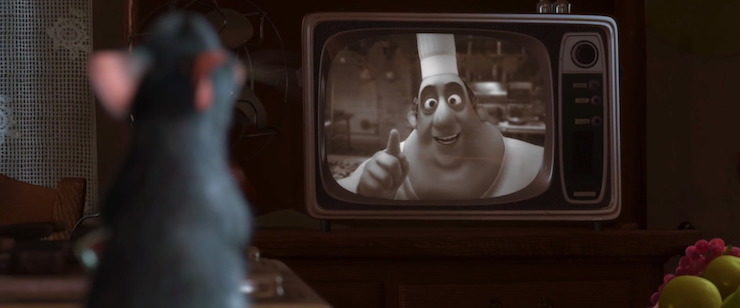 Even better for Disney, Pixar was already moving two more films into completion. Nobody wanted to get overly excited, but the studio thought that perhaps—just perhaps—they were still climbing to new animation peaks. The success of the deal led Bob Iger to take a look at other things Disney could buy—superheroes, maybe. Or spaceships. In the meantime, though, he wanted to know what Pixar could deliver now that it was firmly under Disney’s control.
Even better for Disney, Pixar was already moving two more films into completion. Nobody wanted to get overly excited, but the studio thought that perhaps—just perhaps—they were still climbing to new animation peaks. The success of the deal led Bob Iger to take a look at other things Disney could buy—superheroes, maybe. Or spaceships. In the meantime, though, he wanted to know what Pixar could deliver now that it was firmly under Disney’s control.
Wall-E, coming up next month.
Mari Ness lives in central Florida.










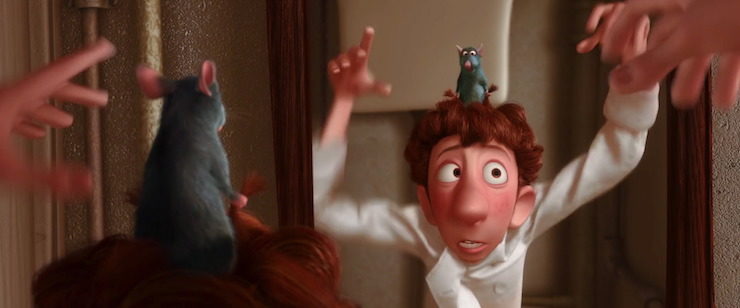
My understanding is that (well, aside from the remote-control-by-rat part) this is one of the better portrayals on film of a high-end restaurant kitchen in action.
Love this film dearly, love the soundtrack dearly, and it’s been way too long since I last watched it.
The scene where the restaurant critic taste the meal and is instantly transported back to his childhood is one of the greatest scenes ever filmed.
I love Ratatouille! The comment about art and criticism and the flashback to the critic’s childhood was outstading!
About female characters, I accept the presence of few female characters because it reflects the structure of the gastronomy world, in fact, Colette’s mentions it to Linguini. I think it’s her best scene.
“three of those creatives end up needing to turn to a formal rival for financial help.”
Typo alert – did you mean “former rival”
P.S. Great article about a movie I enjoy very much.
While the merger was nominally Disney absorbing Pixar, I’ve always seen it as Pixar absorbing Disney, since Lasseter’s creative vision ended up guiding both — which was very much to Disney’s benefit. I was never much of a fan of Disney films before he started making them.
Ratatouille is an excellent one, but the bit about puppeteering a human being by yanking on his hair is the thing that exceeds my suspension of disbelief toward a movie about a sentient talking rat becoming a gourmet chef.
@3/palindrome310: You may be right about the male-dominated gastronomy world, but why couldn’t they have compensated by making some of the rat characters female?
@@@@@5. ChristopherLBennett “…but why couldn’t they have compensated by making some of the rat characters female?”
If you think the gastronomic world is dominated by men, you should see the rat world. A female rat? Whoever heard of such nonsense.
@6 I predict we will soon discover the strength of the rat fandom on this website :P
This is such a sweet movie. My colleague at that time gave me a cute stuffed Emile once since I am born on the year of the Rat and love rats (was a little disappointed it wasn’t Remy, but hey, a rat’s a rat!). Which reminds me … *scuttles off to find the toy*
Probably my favourite Pixar movie. Wall-E has its soaring moments and the Incredibles is fantastic action, but it’s this rat’s story that gets me in the heart every time. The critic’s flashback is right there next to the ending of ‘The Miracle Worker’ for being so affecting.
A peculiar thing about this movie, for me: Remy’s to be able to control the guy via pulling his hair is of course ridiculous by any logical assessment. And I have no problem with it whatsoever: me, who usually critiques things to death. And I shush anyone who tries.
Being mildly obsessed with food blogs, (which is funny since I’m such a picky eater,) this is one of my favorite comfort movies. I loved loved loved the scene where Remy is trying to explain what things taste like, with the different fireworks, as well as how TOUGH Colette is. I’d have liked more females in the movie, but for whatever reason, professional cooking is a male-dominated industry until lately.
Also, just as a note,Carol Keller (no relation to Thomas) has a lovely discussion of Thomas Keller’s byaldi. (It’s a VERY funny blog, even if it’s been over for a long time.)
Summer of 2008 I was on a walking tour in France. I asked our guide what she thought of RATATOUILLE and she said she and everyone she knew who saw it thought it was hysterically funny, and it was a big hit in theaters there.
I remember being disappointed at the time when Disney absorbed Pixar, but in retrospect… nah, I’m still disappointed. The Pixar luster has gradually become diminished, what with their eventual slide into unnecessary sequels (looking at you, Cars) and mediocre outings (you know the ones), and I’m going to lay the blame on Disney, the king of assembly line pablum, and Lasseter, whose “vision” has become nearsighted. Of course, a more independent Pixar may have taken the same trajectory, but we’ll never know.
I loved rats as a kid, mostly due to Templeton in Charlotte’s Web. I have a beloved pet rat, Byral. But I never watched this one, because my younger brother didn’t and my teenage cartoon-watching mode by then was to sneak peeks at whatever he was watching, lest my mom catch me doing something ‘childish.’ (Thank the Drowned Goddess he never watched WALL-E, either). I also was, and remain, unenthusiastic about the look of computer-animated films centered on hums.
Sounds like a well-regarded film here on Tor, though, as it has twice been previously praised.
Does it remind anyone else of the other Rat Cook? ;-)
I didn’t eat at fancy restaurants when visiting Paris, too afraid of overspending. But I discovered panini. Paris has excellent panini.
@6: In the first five Redwall books, all of the rats (and nearly all of the other “vermin”) are male. This only improves somewhat over the long series. But I didn’t expect Ratatouille to have the same problem, as it’s about a rat and his family. What does he have — just father, brothers, uncles, and/or male cousins?
Great article, I learned a lot! Ratatouille is easily my favorite movie of all time.
I think “Eisner left the film” should be “Eisner left the firm”.
@5: Shades of Steve Jobs getting NeXT to take over Apple using Apple’s money; that seems to have worked out pretty well, too. Sometimes getting the successful “fresh outsider” (by that point SJ was an effective outsider at AAPL) into a position where they can combine the power to pursue their vision that they had at the smaller company with the resources available from the larger one is what’s needed.
I must be one of the few people who don’t like this movie. I found the rat control too unbelievable, plus the idea that you could ever run any restaurant with rats just pushed me out of the movie. Also, I think rats are creepy, so that definitely had an impact on my enjoyment of the film. The scene where they all run out of the ceiling, arghhhh.
I love this film, which has just about everything you can imagine thrown into the pot; love, family, greed, art, passion, romance and a protagonist who doesn’t quite fit in. Next to the Incredibles, this is my favorite Pixar film.
This film was probably my least favorite of the Pixar films. I liked the Critic and his speech but the rest of the film felt jumbled and a mess.
It always feels like two films to me, one about Luigi and one about Remmy and the two never really meet in my opinion. The entire arc about selling the restaurant felt tacked on to me.
I’ve always wished someone would have taken a knife to the script, slashed about half of it out, and then fleshed out the remaining half. The way I’d do it would be to slice out everything with Remmy talking and just make him a magic cooking rat and then combine Luigi and Colette into a single character. So you have the story about a good cook having the chance to be a great cook through a cheat.
I didn’t like this movie as much as I hoped to – I love cooking/food, and I have no real aversion to rats, so the idea of a rat as a master chef was appealing to me. But I thought – and yes, I know this is ridiculous given that I was totally willing to buy a story with a rat as a chef – the thing with Remy controlling Luigi like a marionette just destroyed my suspension of disbelief and veered into too slapsticky. I guess I would have just preferred it if Remy was giving him secret instructions and not literally controlling him by pulling his hair.
I liked the various musings on art/critique/following dreams and all that but the premise was a little too hard for me to swallow.
I enjoy this movie quite a bit, but it always strikes me as a bit of a turning point for Pixar, and not just because of the Disney merger. Ratatouille, WALL-E, and Up represent a set of films that changed from “kid films that adults will also enjoy” to “films for adults that kids may also like.” My son was right in the Disney target audience when those movies came out (age 6 to 8) but he never fell in love with those three the way he did with Toy Story or Cars. He watched them in the theater with us, because when you’re that age, and your parents want to take you to the movies, you don’t say no. But I’m not sure he’s ever watched them again on DVD, although we own them. He’s certainly never asked to see them, but he happily watched Cars once a day, the way kids do.
Which isn’t to say that Pixar made a mistake in this era. These three Pixar movies are among my favorites (behind The Incredibles), but they don’t hit for little kids the way their other films do. I think the merchandise sales reflect that.